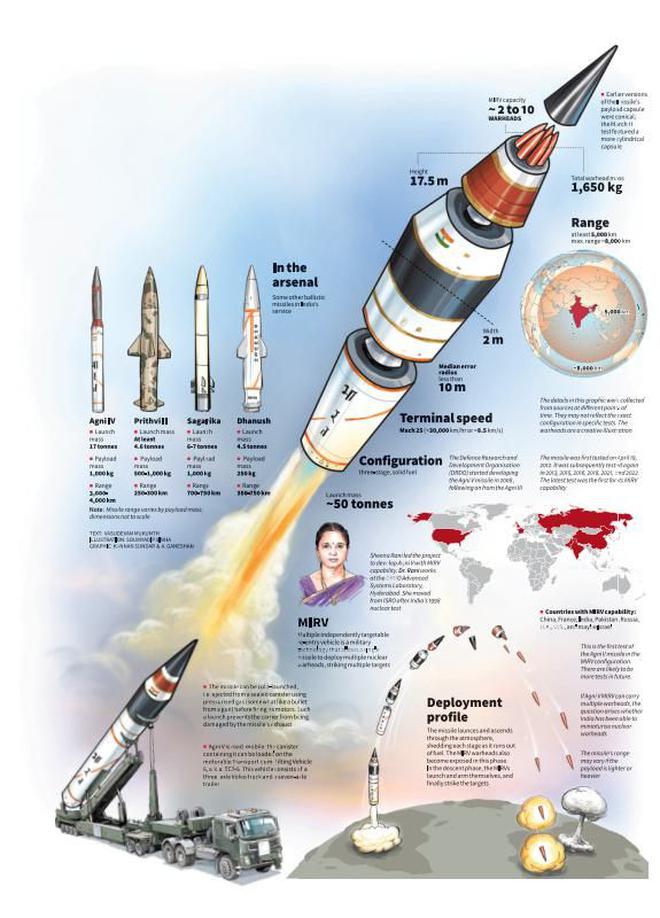The story so far: On March 11, Prime Minister Narendra Modi announced on social media the successful flight test of an Agni V ballistic missile with multiple independently targetable re-entry vehicle (MIRV) technology by the Defence Research and Development Organisation (DRDO) under ‘Mission Divyastra’. It placed India in a small group of countries with this technology, by which a single missile can deliver multiple nuclear warheads.

What are MIRVs and why are they significant?
A MIRV is a ‘missile bus’ whose passengers are nuclear bombs and which facilitates a single booster to deliver them to different targets, Silky Kaur wrote in an article in Air Power Journal in 2022. “In 1970, the U.S. started to deploy the Minuteman III, the first MIRV-ed intercontinental ballistic missile (ICBM) with three warheads on each missile. In 1971, it deployed the Poseidon, the first MIRV-ed submarine-launched ballistic missile (SLBM) which had the capability of carrying up to 10 warheads on each missile,” the article added.
The Soviet Union followed the U.S. and by the 1970s developed its own MIRV-ed ICBM and SLBM technology. A Russian MIRV-ed missile under development may be able to carry up to 16 warheads, each in a separate re-entry vehicle, according to the Centre for Arms Control and Non-Proliferation, and some MIRV-ed missiles can hit targets as far as 1,500 km apart. The U.K. and France also possess the technology.
China has developed and deployed MIRV technology with multiple warheads placed on its DF-5B ICBMs and is fast expanding and modernising its nuclear arsenal. According to Yearbook 2023 of the Swedish think tank Stockholm International Peace Research Institute (SIPRI), China could potentially have at least as many ICBMs as either the U.S. or Russia by the turn of the decade.
In a 1997 Congressional Research Service report for the U.S. Congress, Jonathan Medalia wrote MIRVs are a “force multiplier” because one MIRV-ed missile can strike several targets. “This is especially important for SLBMs; if each missile carries, say, four warheads instead of one, then one submarine can do the work of four, saving a fleet the cost of many missiles and submarines. MIRVs are also useful for saturating and penetrating ballistic missile defences.”
What was the Mission Divyastra test?
The DRDO said in a statement it conducted the test from Dr A.P.J. Abdul Kalam Island in Odisha, with various telemetry and radar stations monitoring multiple re-entry vehicles. “The mission accomplished the designed parameters.”
Sources said the MIRV system is equipped with indigenous avionics systems and high accuracy sensor packages that ensure the re-entry vehicles reach the target points with the desired accuracy. “The capability is an enunciator of India’s growing technological prowess,” sources said. “The project director is a woman and it [the project] has significant contribution by women.”
The ‘Agni’ series of missiles constitute the backbone of India’s nuclear weapons delivery, and Agni V is the longest range missile in the arsenal, with a reach of over 5,000 km. This means it can reach most of China, especially with a smaller warhead, which would increase the range further. MIRV technology gives better leverage in this regard.
Mission Divyastra is significant for several reasons. In 1998, India conducted nuclear tests under Pokhran II. In 2003, it declared its nuclear doctrine based on a ‘no first use’ (NFU) policy and reserved the right to massive retaliation in case it was attacked first. Based on this, India announced its decision to maintain a minimum credible deterrence and a nuclear triad – comprising aircraft, missiles, and submarines – to deliver these nuclear weapons which has since been completed with ballistic missile submarines of the Arihant class conducting deterrence patrols. Specific technical characteristics of the MIRV technology tested are not yet known.
A MIRV-ed missile enhances the redundancy as a single missile can perform the role of several. It can help defeat ballistic missile defences, which is important since India’s adversaries are deploying sophisticated air defences.
What lies ahead?
The technology development is without doubt significant given its sophistication and applications. However, Mission Divyastra was the maiden test of the MIRV technology; there will be a few more tests to validate the various associated components and processes before MIRV-ed Agni V can be declared fit for serial production. The important aspect to look out for now is the reactions from China and Pakistan. There has been a triangular contest between India, China, and Pakistan for long, with China trying to counter the U.S., and India trying to balance the asymmetry with China, and Pakistan, in turn, trying to even the scales with India.







